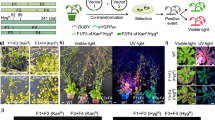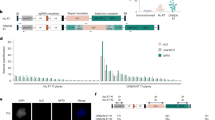Abstract
Recombinant genes conferring resistance to antibiotics or herbicides are widely used as selectable markers in plant transformation. Once transgenic material has been selected, the marker gene is dispensable. We report a novel strategy to remove undesirable parts of a transgene after integration into the tobacco genome. This approach is based on the transfer of a vector containing a NPTII gene flanked by two 352 bp attachment P (attP) regions of bacteriophage λ, and the identification of somatic tissue with deletion events following intrachromosomal recombination between the attP regions. This system was used to delete a 5.9 kb region from a recombinant vector that had been inserted into two different genomic regions. As the attP system does not require the expression of helper proteins to induce deletion events, or a genetic segregation step to remove recombinase genes, it should provide a useful tool to remove undesirable transgene regions, especially in vegetatively propagated species.
This is a preview of subscription content, access via your institution
Access options
Subscribe to this journal
Receive 12 print issues and online access
$209.00 per year
only $17.42 per issue
Buy this article
- Purchase on Springer Link
- Instant access to full article PDF
Prices may be subject to local taxes which are calculated during checkout




Similar content being viewed by others
References
Dale, P.J. Spread of engineered genes to wild relatives. Plant Physiol. 100, 13–15 (1992).
Gressel, J. Indiscriminate use of selectable markers–sowing wild oats? TIBTECH 10, 382 (1992).
Matzke, M.A. & Matzke, A.J.M. Differential inactivation and methylation of a transgene in plants by two suppressor loci containing homologous sequences. Plant Mol. Biol. 16, 821– 830 (1991).
De Block, M. & Debrouwer, D. Two T-DNAs co-transformed into Brassica napus by a double Agrobacterium infection are mainly integrated at the same locus. Theor. Appl. Genet. 82, 257–263 (1991).
Yoder, J.I. & Goldsbrough, A.P. Transformation systems for generating marker-free transgenic plants. Bio/Technology 12, 263–267 (1994).
Puchta, H., Swoboda, P., Gal, S., Blot, M. & Hohn, B. Somatic intrachromosomal homologous recombination events in populations of plant siblings. Plant Mol. Biol. 28, 281 –292 (1995).
Gardner, J.F. & Nash, H.A. Role of Escherichia coli IHF protein in lambda site-specific recombination. J. Mol. Biol. 191, 181–189 (1986).
Yang, C. & Nash, H.A., The interaction of E. coli IHF protein with its specific binding sites. Cell 57 , 869–880 (1989).
Craig, N.L. & Nash, H.A. The mechanism of phage lambda site-specific recombination: site-specific breakage of DNA by Int topoisomerase. Cell 39, 707–716 ( 1984).
Weisberg, R.A. & Landy, A. In Lambda II (eds Hendrix, R.W., Roberts, J.W., Stahl, F.W. & Weisberg, R.A.) 211–250 (Cold Spring Harbor Press, Cold Spring Harbor, NY; 1983).
Galliano, H., Müller, A.E., Lucht, J.M. & Meyer, P. The transformation booster sequence is a retrotransposon derivative that binds to the nuclear scaffold. Mol. Gen. Genet. 247, 614–622 (1995).
Urwin, P.E., Atkinson, H.J., Waller, D.A. & McPherson, M.J. Engineered oryzacystatin-I expressed in transgenic hairy roots confers resistance to Globodera pallida. Plant J. 8, 121–31 (1995).
Depicker, A.G., Jacobs, A.M. & Van Montagu, M.C. A negative selection scheme for tobacco protoplast-derived cells expressing the T-DNA gene 2. Plant Cell Rep. 7, 63–66 (1988).
Puchta, H. & Hohn, B.A transient assay in plant cells reveals a positive correlation between extrachromosomal recombination rates and length of homologous overlap. Nucleic Acids Res. 19, 2693–2700 (1991).
Roth, D. & Wilson, J. In Genetic recombination (eds Kucherlapati, R. & Smith, G.R.) 621–653 (American Society for Microbiology, Washington, DC; 1988).
Puchta, H. & Meyer, P. In Homologous recombination and gene silencing in plants (ed. Paszkowski, J.) 123– 155 (Kluwer Academic Publishers, Dordrecht, The Netherlands; 1994).
Swoboda, P., Hohn, B. & Gal, S. Somatic homologous recombination in planta : the recombination frequency is dependent on the allelic state of the recombining sequences and may be influenced by genomic position effects. Mol. Gen. Genet. 237, 33–40 (1993).
Koncz, C. et al. Specialized vectors for gene tagging and expression studies. Plant Mol. Biol. Manual B2, 1–22 (1994).
Horsch, R.B. et al. A simple and general method for transfering genes into plants . Science 227, 1229–1231 (1985).
Konz, C. & Schell, J. The promoter of TL-DNA gene 5 controls the tissue-specific expression of chimeric genes caried by a novel type of Agrobacterium binary vector. Mol. Gen. Genet. 204, 383–396 ( 1986).
Chalfie, M., Tu, Y., Euskirchen, G., Ward, W.W. & Prasher, D.C. Green fluorescent protein as a marker for gene expression . Science 263, 802–805 (1994).
Velten, J. & Schell, J. Isolation of a dual plant promoter fragment from Ti plasmid of Agrobacterium tumefaciens. EMBO J. 3, 2723–2730 ( 1984).
Dellaporta, S.J., Wood, J. & Hicks, J.B. A plant DNA minipreparation. Plant Mol. Biol. Rep. 1, 19–21 ( 1983).
Van Blokland, R., Ross, S., Corrado, G., Scollan, C. & Meyer, P. Developmental abnormalities associated with deoxyadenosine methylation in transgenic tobacco. Plant J. 15, 543–551 (1998).
Koes, R.E., Spelt, C.E., Mol, J.N.M. & Gerats, G.M. The chalcone synthase multigene family of Petunia hybrida (V30): sequence homology, chromosomal localization and evolutionary aspects. Plant Mol. Biol. 10, 159–169 ( 1987).
Acknowledgements
We would like to thank Dr Peter Urwin for providing the effector gene. This work was supported by a Scottish Office grant, “Transgenic control of nematodes.”
Author information
Authors and Affiliations
Corresponding author
Rights and permissions
About this article
Cite this article
Zubko, E., Scutt, C. & Meyer, P. Intrachromosomal recombination between attP regions as a tool to remove selectable marker genes from tobacco transgenes. Nat Biotechnol 18, 442–445 (2000). https://doi.org/10.1038/74515
Received:
Accepted:
Issue Date:
DOI: https://doi.org/10.1038/74515
This article is cited by
-
Agrobacterium rhizogenes-mediated marker-free transformation and gene editing system revealed that AeCBL3 mediates the formation of calcium oxalate crystal in kiwifruit
Molecular Horticulture (2024)
-
Recent Advances in Antibiotic-Free Markers; Novel Technologies to Enhance Safe Human Food Production in the World
Molecular Biotechnology (2023)
-
A novel non-antibiotic selectable marker GASA6 for plant transformation
Plant Cell, Tissue and Organ Culture (PCTOC) (2022)
-
Comparison of three Agrobacterium-mediated co-transformation methods for generating marker-free transgenic Brassica napus plants
Plant Methods (2020)
-
The usage of snapdragon Delila (Del) gene as a visible selection marker for the antibiotic-free transformation system
Journal of Plant Biology (2015)



